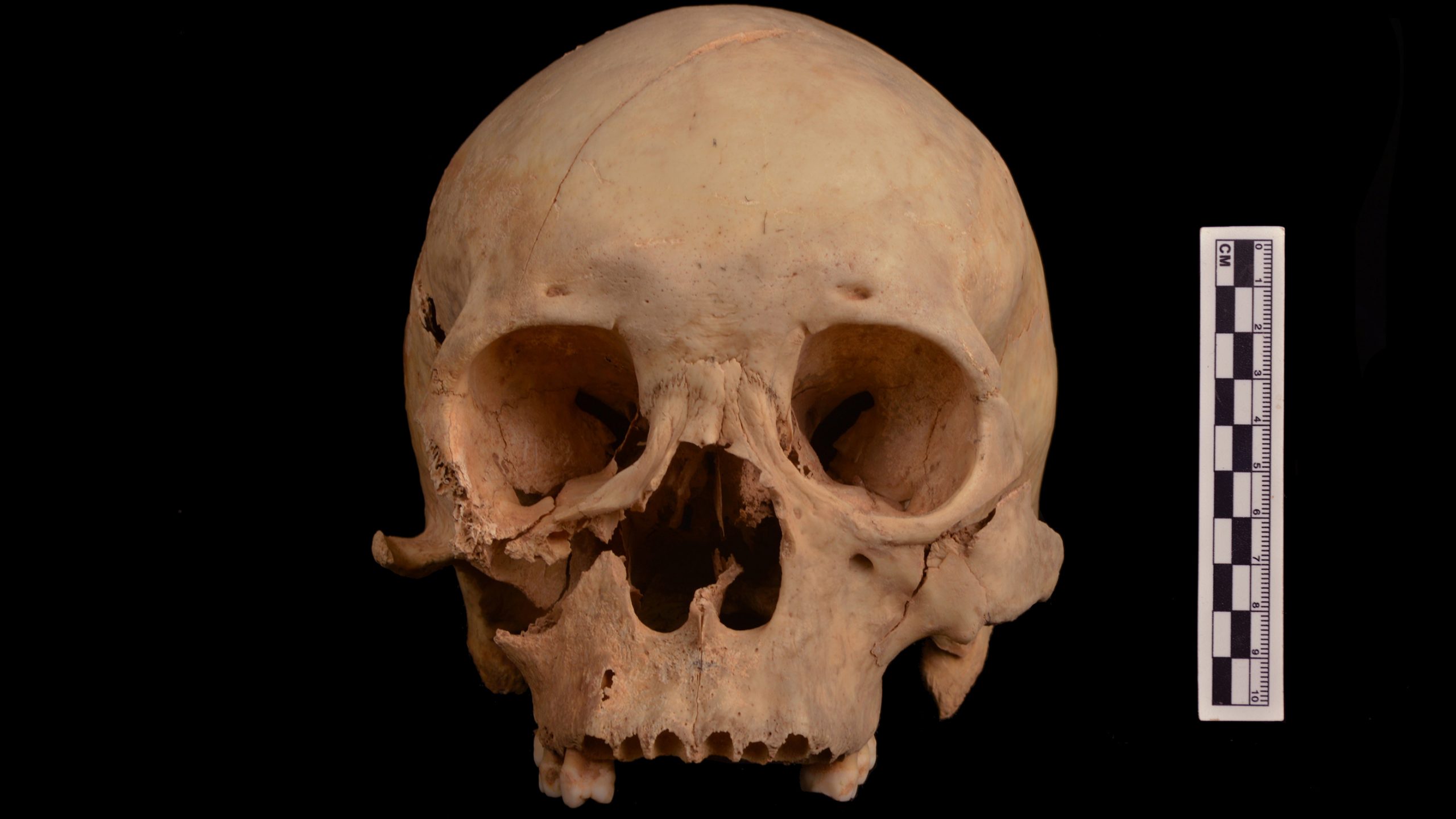Mystery of a man who died 1300 years ago in China is SOLVED
الصين تكتشف جريمة قتل غامضة قبل 1300 عام
SCMP
He will not get the justice he deserved, but, thanks to new research from a team of scientists, we can now piece together the story of a man who was probably murdered 1,300 years ago in northwest China.
Furthermore, in investigating the case, scientists suggested the killer or killers tried to cover their tracks by “hiding a leaf in a forest”, or, to be more accurate, hiding the body in a graveyard to avoid detection.
In a report published in October in Archaeological and Anthropological Sciences the team of scientists detailed how they were able to ascertain a series of events from 1,300 years ago.
The final resting place of the victim was a tomb in Shiyanzi cemetery, in the northwest autonomous region of Ningxia, which contained 10 other tombs.
The cemetery was first discovered in 2002 by people constructing a gas pipeline and was excavated twice, in 2009 and 2011. The tomb investigated in the report contained four people: a man, a woman, a juvenile and, separated from the rest of them, the body of the victim.
The layout suggested that the original inhabitants of the tomb were a family, but the other body seemed unrelated to them.
An important piece of information is that the Shiyanzi cemetery had been thoroughly robbed over its history, and the man’s body was found in a shaft used by grave robbers to more easily loot the tomb.
Wang Qian, a professor at the Department of Biomedical Sciences at Texas A&M University and lead author of the study, told the South China Morning Post that the family was probably wealthy.
“The grave goods must have been very rich, which led to a large-scale grave robbery evidenced by the vertical robbery shaft,” he said.
After performing an age analysis on the skeleton, they determined it was 700 years younger than the original inhabitants, leading the scientists to hypothesise that the man was a grave-robber who had been killed or died in an accident while trying to steal from the tomb.
The theory would be supported by Chinese history. The scientists pointed to the case of a skeleton from the Ming dynasty (1368 to 1644) that was found in a tomb built during the Tang dynasty (618 to 907). The skeleton from the Ming dynasty was 800 years younger than the original inhabitants and was believed to have been killed when the tomb collapsed while he was robbing it.
While the laws against grave-robbing throughout Chinese history have been harsh, there has existed a tradition of “official robbery”, whereby governments and militaries would pillage cemeteries for valuables to raise money.
The scientists pointed to Cao Cao, a warlord from the Three Kingdoms period who infamously ordered his army to rob graves to generate revenue for the military.
“Because of the sheer size and amount of work … it is possible that the robbery was an organised grave robbery by the army or the militia to subsidise military spending, most probably during late Eastern Han dynasty (25-220) or the disturbing years after that,” said Wang.
In the paper, the team wrote: “The individual in the grave-robbing shaft was initially presumed to be a grave robber.”
The Attack
Working on the hypothesis that the man was a tomb raider, the team began to investigate the skeleton, which was discovered in a supine position, with his left arm stretched over his head and his right hand covering his face.
Upon examining the skeleton, the team discovered 13 “V-shaped sharp-force marks” on the skeleton. The most extreme cuts were on the face, but the scientists said those would likely cause a lot of pain and bleeding but were unlikely to be fatal.
The potentially deadly injuries showed on the ribs, because it is plausible those attacks punctured a vital organ like the lungs or heart.
Marks on the back of the head point to him being attacked while he was turned away and there were also sharp-force marks on the man’s legs and arms, suggesting defensive wounds.
The scientists were clear to say the injuries came from a sharp object and said there was no evidence of blunt-force trauma, like, say, from a club or rock.
“The individual may have died immediately or shortly after the assault,” the team wrote.
While the scientists could not determine what blow had actually killed the man, the picture had emerged of a sustained assault in which the man was stabbed multiple times.
The Cover-up
The scientists think the man either died outside the tomb and was thrown into the shaft, or he fell into the hole, where he then died.
Regardless, the state of the shaft was important because it had been half-filled with soil and the remains of animals.
The animal, which would have fallen into the shaft and died, were a nuanced piece of evidence that told the team that the shaft had been out of use for a long time when the man died, potentially for centuries
This means that the man could not have been part of the robbery team that built the shaft.
The team moved away from their original hypothesis, saying the evidence pointed to a man who was the victim of a homicide.
“We can conclude that the assault victim was not part of the original robbery team based on the fact that the filling of the vertical robbery shaft is accumulated naturally, and the victim was found about 4.5m above the floor of the burial chamber – which means it should be a significant long time after the robbery,” said Wang.
“The team said that after the man was killed, or was dying, he was dumped into the tomb to keep the crime a secret,” he said.
The murdered man lived during the Tang dynasty, which deployed capital punishment for the crime of murder or assault leading to severe injury. If found guilty, the killer would have either been decapitated or hanged.
The study said: “While killing might be insensible, the disposal of the victim is always sensible, in which sociopolitical factors would decide whether killings and victims would be hidden or made public.”
These factors, the team suggested, inspired the killer to hide the body because he could have faced the death penalty if caught. This logic probably motivated the murderer to “hide a leaf in the forest” so the body was never found.
“The victim thus disappeared without a trace in a then 700-year-old cemetery, and his remains were not found until the discovery and excavation of the cemetery 1,300 years later.”
The scientists suggested that the analysis is insightful in understanding the history of homicide. Specifically, it points to the human condition of returning to one’s senses after committing a crime, and thinking rationally about how to get away with it.
“The strategy of ‘hiding a leaf in the forest’ was a success in this – the identities of the victim and the perpetrator/s are lost to history and will never be known,” the team wrote.
“There will be no punishment either.”
وكالات
كشفَ علماءُ آثار في الصين ملابسات مصرع شاب كان قد قتل قبل نحو 1300عام. وكان قد عثر على هيكل عظمي للشاب في الصين خلال عمليات تنقيب جرت في مقبرة شي يانغتسي، الواقعة في منطقة نينغشيا ذاتية الحكم. ووجد الرفات في نفق حفره لصوص. وبفحص الهيكل العظمي من قبل الاختصاصيين، عثر على آثار جروح ناجمة عن طعنات. ويعتقد العلماء أن الرجل، ويبلغ من العمر 25 عامًا تقريبًا، كان لا يزال على قيد الحياة حين أُلقي به في النفق وتُرك هناك ليموت. ويدفع علماء الآثار بفرضية تقول: إنّ جريمة القتل ارتُكبت بين عامَي 640 و680 بعد الميلاد.




